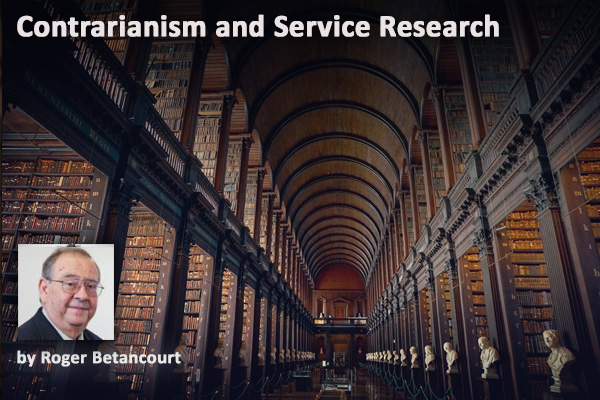guest article by Roger Betancourt
I am attracted to differences that entail novelty and I am somewhat skeptical of established orthodoxies or norms supported by appeals to authority of one kind or another. The result of both inclinations is a tendency to be a contrarian in my approach to research endeavors.
My first encounter with service research took place during 1989 in collaboration with David Gautschi while on sabbatical at INSEAD. We set out to find essential differences between goods and services. Instead we found a result that contradicted conventional wisdom: simultaneity of consumption and production in space and time is not an essential characteristic of services that differentiates them from goods (Betancourt and Gautschi 2001: Proposition 3).
Our discovery process relied on identifying three primitive economic activities (production, distribution and consumption) and thinking of them as taking place jointly or separately in terms of the basic human coordinates of space and time. It led to a Tableau of Primitive Economic Activities with 25 cells that eventually generated additional service research.
A publication lag of 12 years between the original idea and its official publication, however, dampened my enthusiasm for service research. It was revived thanks to Jim Spohrer who sent me an email out of the blue in 2009 praising the 2001 paper, offering to have me in for a seminar in San Francisco, and noting the paper was cited in a forthcoming JM article (Keh and Pang 2010). The latter did so in support of experiments showing that space separation mattered to consumers. I had to decline Jim’s invitation. There was no further work on the 2001 paper. My research on democracy did not seem a good fit with Jim’s crowd. Nonetheless, intellectual support from an individual highly trained in physics and computer science and interest from marketing scholars were stimulating. It led to thinking again about aspects of service research first encountered 20 years earlier. Incidentally, Tat Keh had been an auditor in a PH. D. seminar on ‘The Economics of Retail Systems’ I co-taught with D. Gautschi at UW in1996.
In 2011 coauthors in the Marketing Department at Universidad Pública de Navarra in Spain wanted to apply for a grant from their country’s equivalent to the NSF. I suggested exploring development of the results in the 2001 paper based on the renewed interest just described. They agreed. The grant led to exciting new insights relevant for service research. This time the process focused on one cell in the Tableau: the one involving the retailing of goods where the primitive economic activities of production, distribution and consumption take place separately in space and time. By doing so we looked inside the cell or at the subatomic level viewing the cell as an atom. Once again the contrarian streak struck as one strand of current conventional wisdom in marketing contemplates doing away with the ‘old fashioned’ idea of goods. Goods and services are tied in many different ways. No single approach is capable of addressing them all in useful ways for researchers or practitioners.
Since distribution services provided by the retail sector to consumers are the same in principle whether provided by B&M retailers or Internet ones, we were able to discover the essential feature of Internet retailing in the provision of these services for the distribution of goods: Namely, it can separate the production, distribution and consumption of each of these distribution services in space and time (Betancourt, Chocarro, Cortiñas, Elorz and Mugica 2016: Proposition 1). I presented the result and its consequences at the 2015 Frontiers in Service Conference where I finally met Jim Spohrer, thanked him for his support, and discovered the conference had originated due to efforts of my Maryland colleague Ronald Rust.
The above paper led to explaining the emergence of a unique 21st century institution that functions exclusively online (private sales clubs) with a novel link to marketing literature on customer satisfaction and intentional loyalty (Betancourt, Chocarro, Cortiñas, Elorz and Mugica 2017). These results were presented at the 2016 Frontiers in Service conference.
A contrarian inclination led earlier service research to focus on marketing issues. My current research (Betancourt 2017) changes focus by addressing economic issues (GDP measurement, productivity and household welfare). Furthermore, it extends the analysis of Internet retailing to service sectors besides retail. It was presented for the first time in the non-economics oriented but service research friendly confines of the 2017 Frontiers in Service Conference. Subsequently, it was presented at the economics oriented 2017 SEM/MIT conference on the digital economy. Somewhat surprisingly, I have not been ex-communicated!
Read more from Roger here
Betancourt, Roger, Raquel Chocarro, Monica Cortiñas, Margarita Elorz, and Jose M. Mugica. 2016. ” Channel Choice in the 21st Century: The Hidden Role of Distribution Services,” Journal of Interactive Marketing, 33 (February), 1-12.
Betancourt, Roger, Raquel Chocarro, Monica Cortiñas, Margarita Elorz, and Jose M. Mugica. 2017. “Private Sales Clubs: A 21st Century Distribution Channel,” Journal of Interactive Marketing, 37 (February), 44-56.
 Roger Betancourt
Roger Betancourt
Department of Economics
University of Maryland
References
Betancourt, Roger. 2017 “Distribution Services and the Digital Economy: Implications for GDP Measurement, Productivity and Household Welfare” typescript, University of Maryland. Available at http://econweb.umd.edu/~betancourt/distribution/DS%20and%20teh%20digitla%20economy.%20Version%202.0.pdf
Betancourt, Roger and David Gautschi.2001. “Product Innovation in Services: A Framework for Analysis,” in Advertising and Differentiated Products, Vol. 10 of Advances in Applied Microeconomics, M.R. Baye and J.P. Nelson (eds.) Elsevier Science Ltd., Oxford UK,155-83.
Keh,Tat and Jun Pang. 2010. “Customer Reactions to Service Separation,” Journal of Marketing, 74 (2) 55-70.


